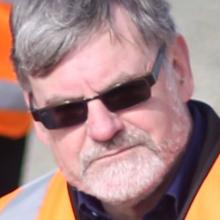Oamaru's little blue penguins will be protected by sand sausages after all.

Foreshore protection work north of Holmes Wharf has been delayed over the past year, but last week Waitaki District Council roading manager Michael Voss confirmed the council had awarded the contract for the $770,000 project in front of Oamaru Creek’s blue penguin colony to Paul Smith Contracting Ltd.
To minimise the disruption to the birds, work would begin at the site in eight weeks and was scheduled to finish in August, Mr Voss said.
The timing of the project had been planned in conjunction with the Oamaru Blue Penguin Colony, which monitors the Oamaru Creek colony as well as the colony at the old quarry site in Oamaru Harbour.
"While it’s a construction job there’s actually quite a bit of ... flora and fauna-type engineering as well," Mr Voss said.
"We’ve got a whole raft of sensitivities."
Oamaru Blue Penguin Colony marine biologist Dr Philippa Agnew said she had briefed the contractors on penguin habits and Oamaru Blue Penguin Colony staff would continue their weekly monitoring of the nests at the site while the work was under way.
The site comprises 252 nesting boxes. The birds would have finished breeding when work began and adults could be away from the colony for longer periods, up to two weeks at a time. Only 20 to 30 chicks at the colony had yet to fledge, after more than 180 eggs hatched this breeding season.
Adults would then moult and thereafter the colony would be "virtually empty", Dr Agnew said.
"They are not a migratory species ... they will stay in the colony, but they will come and go for longer periods," she said.
"And there’s nothing to keep them there. So if they decide to go away for a couple of weeks at a time, they will."
In her 10 years at the Oamaru Blue Penguin Colony "an awful lot of ground [had been] lost" to erosion and the colony would undergo a shift as contractors installed the geotextile sand-filled mattresses 240m along the shoreline between Oamaru Creek and Holmes Wharf. The fencing surrounding the colony would be moved 7m inland and extended 20m further north to create more space for the penguins.
In May last year, Mr Voss told the Otago Daily Times he hoped the work would begin in the winter.
Then in July, he said the consenting process with the Otago Regional Council was progressing "slowly’’ from the district council’s perspective.
After the consent was granted, the project faced another potential delay as the tender documents for the work allowed for the possibility of rock armouring, instead of the 30cm geotextile tube sand mattresses the council had received consent for.
Coast Care’s Lorraine Adams, who in 1990 during a beach clean-up discovered the Oamaru Creek site was contaminated by a former timber treatment plant, said the sand mattresses would "destroy" the beach. She favoured rock armouring and remained unconvinced the work would not disturb the remaining contaminants.
She also questioned the cost-effectiveness of sand sausages, which would need to be replaced.
"A rock is a one-off cost," she said.
"I just find it unbelievable they are going ahead with the work. I just don’t think they have thought it through enough. People need to go down to the foreshore because it is going to be changed forever."












